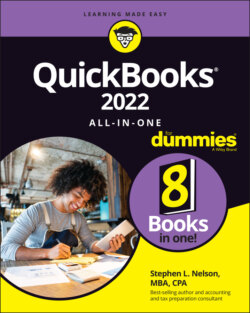Читать книгу QuickBooks 2022 All-in-One For Dummies - Nelson Stephen L., Stephen L. Nelson - Страница 36
Double-Entry Bookkeeping
ОглавлениеIN THIS CHAPTER
Checking out the fiddle-faddle method of accounting
Grasping how double-entry bookkeeping works
Looking at an (almost) real-life example
Figuring out how QuickBooks helps
The preceding chapter describes why businesses create financial statements and how these financial statements can be used. If you’ve read Book 1, Chapter 1, or if you’ve spent much time managing a business, you probably know what you need to know about financial statements. In truth, financial statements are pretty straightforward. An income statement, for example, shows a firm’s revenue, expenses, and profits. A balance sheet itemizes a firm’s assets, liabilities, and owner’s equity. So far, so good.
Unfortunately, preparing traditional financial statements is more complicated and tedious. The work of preparing financial statements — called accounting or bookkeeping — requires either a whole bunch of fiddle-faddling with numbers or learning how to use double-entry bookkeeping.
In this chapter, I start by describing the fiddle-faddle method. This isn’t because I think you should use that method. In fact, I assume that you eventually want to use QuickBooks for your accounting and, by extension, for double-entry bookkeeping. But if you understand the fiddle-faddle method, you’ll clearly see why double-entry bookkeeping is so much better.
After I describe the fiddle-faddle method, I walk you through the steps to using and understanding double-entry bookkeeping. After you see all the anguish and grief that the fiddle-faddle method causes, you should have no trouble appreciating why double-entry bookkeeping works so much better. And I hope you’ll also commit to the 30 or 40 minutes necessary to learn the basics of double-entry bookkeeping.
